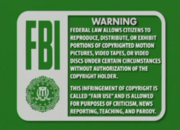Fair Use draft
From DigitalRhetoricCollaborative
Fair use is a doctrine added to the US copyright laws that allows for works to be reproduced without permission under certain circumstances. Some of these circumstances include academic settings, where they use the information to teach others about the subject.
Contents |
Fair Use on the Internet
Court Cases
Legislation about Fair Use
Fair use is referred to as a doctrine, not a law. Being a doctrine means that rulings on this issue are made using other legislation pertaining to the topic of copyrighting.
The doctrine of fair use is not a law by itself, but it is incorporated into multiple other pieces of legislation pertaining to copyright. Below are some of the laws and acts that are used when making cases about fair use.
US Copyright Law
The United States passed the Copyright Act in 1976. This act prevents the unauthorized replication of a work. The copyright only covers the exact replication of a work; the ideas held within the work are not protected. Because of the copyright act, any author or creator is not required to have to register with the copyright office or put a seal on their work; it is automatically protected.
Protection under the copyright law applies to published and unpublished works. These works include any kind of intellectual property such as music, art, literature, etc.
Within the copyright act, there is a provision for the doctrine of fair use in Section 107.
- The U.S. Copyright office has a statement about the doctrine of fair use as it is presented in section 107 of the copyright law.
- These attributes will also be considered when using an unpublished source.
Fair Use - Section 107
Section 107 of the copyright act gives the conditions under which a reproduction of a work is able to be used without gaining permission first. This exemption can be used by teachers and professionals alike to share information and knowledge with peers and students without using valuable time to get permission to share the information.
There are four factors that influence the decision as to whether or not a piece is being used fairly. The factors are:
- The purpose and character of the use, including whether such use is of commercial nature or is for nonprofit educational purposes
- The nature of the copyrighted work
- The amount and substantiality of the portion used in relation to the copyrighted work as a whole
- The effect of the use upon the potential market for, or value of, the copyrighted work (ref)
FAIR USE Act
- The FAIR USE Actalso deals with the idea of copyrighting and redistribution, but it has a different agenda. FAIR USE stands for “Freedom and Innovation Revitalizing United States Entrepreneurship Act of 2007”. This was a proposed law that was never passed, but it posed problems for the Digital Millenium Copyright Act.
Digital Millennium Copyright Act
- The Digital Millennium Copyright Act was passed in 1996 and enforces the protection of technology that enforces copyright laws.
Prominent People
Hector Postigo - “The Digital Rights Movement:The Role of Technology in Subverting Digital Copyright”
Dr. Postigo is an Associate Professor at Temple University in Philadelphia, Pennsylvania. He teaches in the Department of Broadcasting, Telecommunications, and Mass Media. He has written two books that focus on the Digital Rights movement and the effect on copyright laws.

